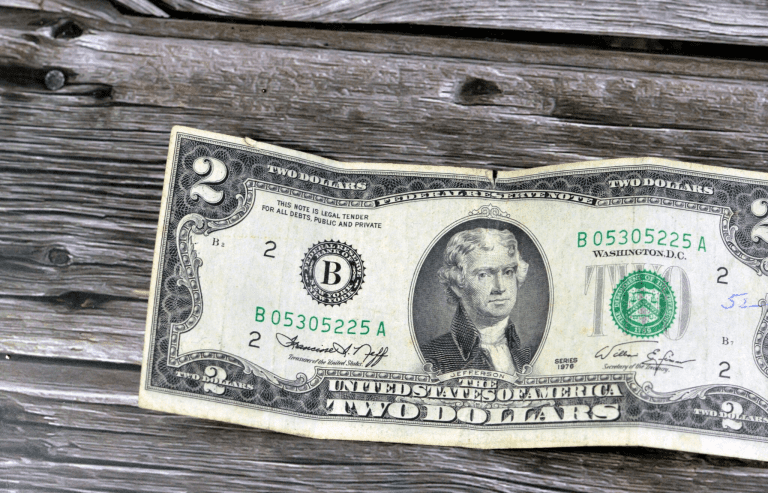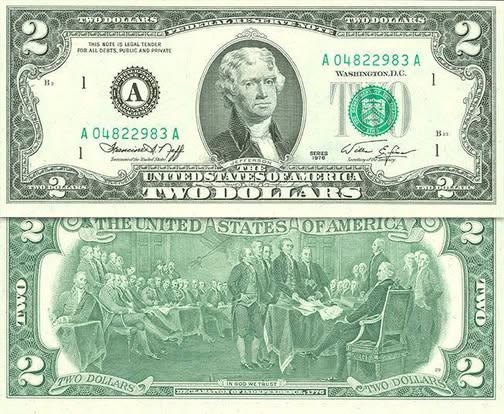Let’s be honest — we’ve all got that one lonely $2 bill stashed somewhere. Maybe it’s tucked inside a birthday card from years ago or hiding in the back of your wallet. Most people forget it even exists. But here’s the twist: that unassuming little note could be worth way more than its face value.
Not kidding. Some of these bills have sold for hundreds or even thousands of dollars. And it’s not just about being old — the details matter. Ready to find out if you’re holding a hidden treasure?

Why the $2 Bill Was Once the Outcast of U.S. Currency
For a long time, the $2 bill was seen as the weird cousin in the world of U.S. money. First printed back in 1862, it never really caught on with the public. Superstitions made things worse. Gamblers believed it brought bad luck — some even tore off corners of the bill to “break the curse.”
By the 1920s, newspapers reported how rarely people used them. They were hoarded, avoided, or tossed aside as too quirky. But while most ignored them, collectors paid attention. And now, all that avoidance is finally paying off.
Video: Got a $2 bill? It could be worth thousands
Are $2 Bills Still Printed? You Bet They Are
Despite all the myths floating around, $2 bills are still in production. As of 2023, about 1.6 billion are in circulation. Sounds like a lot, right? Not really. Compare that to the 14.5 billion $1 bills floating around, and you’ll see why the deuce is considered rare.
In 2004, only 70 million were circulating. Over the years, appreciation for the bill has grown — turning it from a misfit into a fan favorite. It’s quirky, sure. But collectors love quirky.
From Hamilton to Jefferson: The Bill’s Makeover History
Here’s a fun fact: the very first $2 bill featured Alexander Hamilton. That was back in 1862. But in 1869, he got swapped out for Thomas Jefferson — and he’s been the face of the deuce ever since.
The reverse side has also evolved. At first, it showed Jefferson’s Monticello home. But in 1976, it was updated to show the signing of the Declaration of Independence. That design change added historical depth and gave collectors something else to chase.
What Makes a $2 Bill Valuable? Let’s Break It Down

Not all $2 bills are equal. If you want to know whether yours is valuable, you’ll need to check these key features:
Year of Issue: Older is better. Bills from 1862–1896 are especially valuable.
Seal Color: Red, blue, and brown seals mean vintage. Most modern bills have green seals.
Condition: Crisp, uncirculated bills fetch higher prices. A mint-condition bill from the early 1900s could be worth $5,000.
Serial Number: Look for repeating digits, palindromes (like 1234321), or star notes — they can seriously raise the value.
It might sound crazy, but that slightly worn, oddball bill in your wallet could be your lucky ticket — especially if it checks more than one of these boxes.
Specific $2 Bills to Watch For
Video: The Reason $2 Bills Are So Rare Today 🤔 (EXPLAINED)
Let’s get specific. Here are a few standout types that collectors go wild for:
Red Seal Bills (1928, 1953, 1963)
These are very collectible. Depending on condition, they range from $10 to $500.
Blue Seal Bills (1917 and earlier)
Harder to find. Even in average shape, they can sell for hundreds.
Brown Seal Nationals (1800s)
These are ultra-rare. If you find one, don’t spend it — call an appraiser. It could be worth thousands.
1963 Star Notes
If your bill has a little star in the serial number, it’s a replacement note — and collectors love them.
So before you tip your barista with a two-dollar bill, make sure it’s not worth more than your weekly grocery run.
How to Find Out What Your $2 Bill is Worth

If you’ve got one of these bills and think it might be valuable, don’t guess. Here’s what you can do:
Check Online Auction Sites
eBay and USCurrencyAuctions.com often list $2 bills with current prices. Look for completed listings to see what they actually sold for.
Visit a Currency Dealer
Certified professionals can examine the condition, seal, and serial number to give you an accurate appraisal.
Go to a Collector Expo
Coin and currency events are great for learning, selling, and meeting serious buyers.
Just be careful — the rarer your bill, the more likely someone will try to lowball you. Always research who you’re dealing with.
Why the $2 Bill Is Suddenly Cool Again
Went to withdraw a bunch of $2 bills for WPAFW, and one of them was almost 100 years old pic.twitter.com/9i1bL4BXaY
— Sketchy Mouse (@SketchyMouse) September 27, 2024
Once seen as unlucky, the $2 bill is making a comeback. Now it’s a conversation starter, a collectible, and even a fun gift. People are framing them, giving them to grads, or just tucking them away like lucky charms.
There’s even a 2015 documentary called The Two Dollar Bill that dives into its quirky legacy. Safe to say, the deuce is finally getting the respect it deserves.
Conclusion: That Little Bill Could Be a Big Deal
Before you laugh off that dusty $2 bill, give it a second look. What might seem like spare change could actually be a rare piece of history. With the right year, serial number, and condition, it could be worth hundreds — or even thousands.
In a world of mobile payments and vanishing cash, it’s kind of amazing to think that this little green slip could still hold such surprise value. So go check your drawers. Flip through those old birthday cards. Who knows? You might already be richer than you think.


